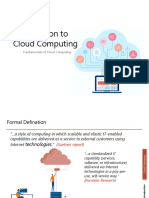0% found this document useful (0 votes)
4 views2 pagesCloud Computing
Cloud Computing delivers computing services over the internet, allowing users to pay only for what they use. Key characteristics include on-demand self-service, broad network access, resource pooling, rapid elasticity, and a pay-as-you-go model. It encompasses various service models (IaaS, PaaS, SaaS) and deployment models (public, private, hybrid), offering advantages like cost-effectiveness and scalability, while facing challenges such as data security and internet dependency.
Uploaded by
shwetakhandagale2005Copyright
© © All Rights Reserved
We take content rights seriously. If you suspect this is your content, claim it here.
Available Formats
Download as DOCX, PDF, TXT or read online on Scribd
0% found this document useful (0 votes)
4 views2 pagesCloud Computing
Cloud Computing delivers computing services over the internet, allowing users to pay only for what they use. Key characteristics include on-demand self-service, broad network access, resource pooling, rapid elasticity, and a pay-as-you-go model. It encompasses various service models (IaaS, PaaS, SaaS) and deployment models (public, private, hybrid), offering advantages like cost-effectiveness and scalability, while facing challenges such as data security and internet dependency.
Uploaded by
shwetakhandagale2005Copyright
© © All Rights Reserved
We take content rights seriously. If you suspect this is your content, claim it here.
Available Formats
Download as DOCX, PDF, TXT or read online on Scribd
/ 2
























































